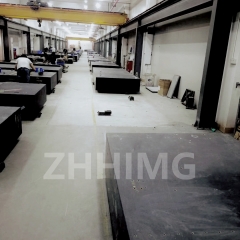Granite is one of the most popular materials for building components in semiconductor equipment, and for good reason. The unique properties of granite give it a distinct advantage over other materials, making it an ideal choice for the challenges faced in the semiconductor industry. There are several unique advantages of granite components in semiconductor equipment, so let’s take a closer look.
Firstly, granite is known for its high dimensional stability. The material is extremely hard and dense, allowing it to maintain its shape and size despite environmental factors such as temperature and humidity. This helps to prevent any deformation in the equipment and ensures long-term stable performance. This is important for semiconductor equipment, which operates under very specific and precise conditions.
Secondly, granite has an excellent vibration dampening capacity. In semiconductor equipment, vibration can cause unwanted noise, disrupt measurements, and even damage sensitive components. The high density and stiffness of granite help to absorb vibrations and reduce their impact on the equipment. This leads to more reliable and consistent performance.
Thirdly, granite is highly resistant to chemical corrosion. The semiconductor industry involves the use of harsh chemicals, and the components used in these processes need to resist degradation or damage from these chemicals. Granite, with its inert properties, is ideal for this purpose. It is not affected by acids or bases, and it can withstand exposure to high temperatures and pressures.
Fourthly, granite has a low thermal expansion coefficient. When components are exposed to varying temperatures, they expand and contract, which can cause mechanical stress and lead to failure. Granite’s low thermal expansion coefficient means that it is less prone to thermal stress, improving the reliability of semiconductor equipment.
Lastly, granite has excellent machinability and is easy to work with. It can be cut and shaped with high accuracy and precision, making it ideal for manufacturing parts with complex geometries. This ease of machining provides designers with greater flexibility and enables them to create components with the exact specifications needed for each equipment.
There are other materials available on the market that can be used in semiconductor equipment, but granite stands out as an outstanding choice given its unique properties. Its dimensional stability, excellent vibration dampening capabilities, resistance to chemical corrosion, low thermal expansion coefficient, and easy machinability make it an ideal choice for creating robust and reliable components for semiconductor equipment.
In conclusion, the advantages of granite components in semiconductor equipment are clear. As a result, it is not surprising that this material is widely adopted in this industry. By leveraging the unique properties of granite, manufacturers of semiconductor equipment can create highly precise, efficient, and reliable equipment, which ultimately benefits the semiconductor industry as a whole.
Post time: Apr-08-2024

